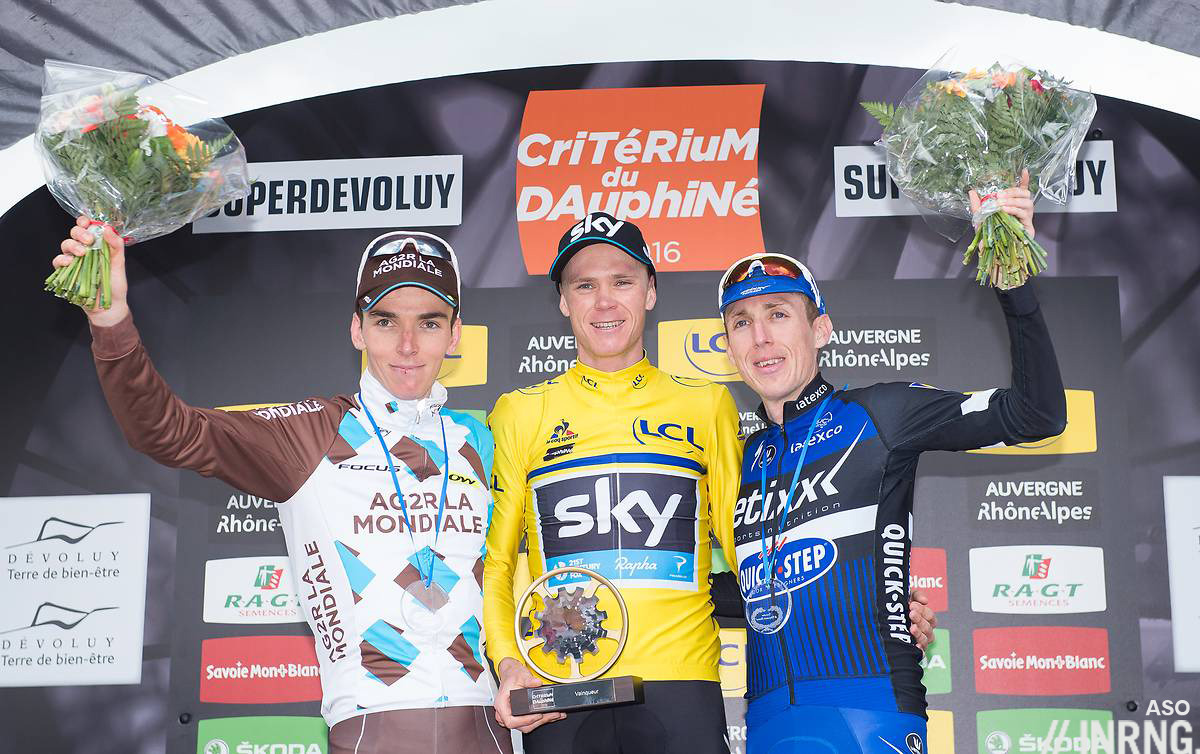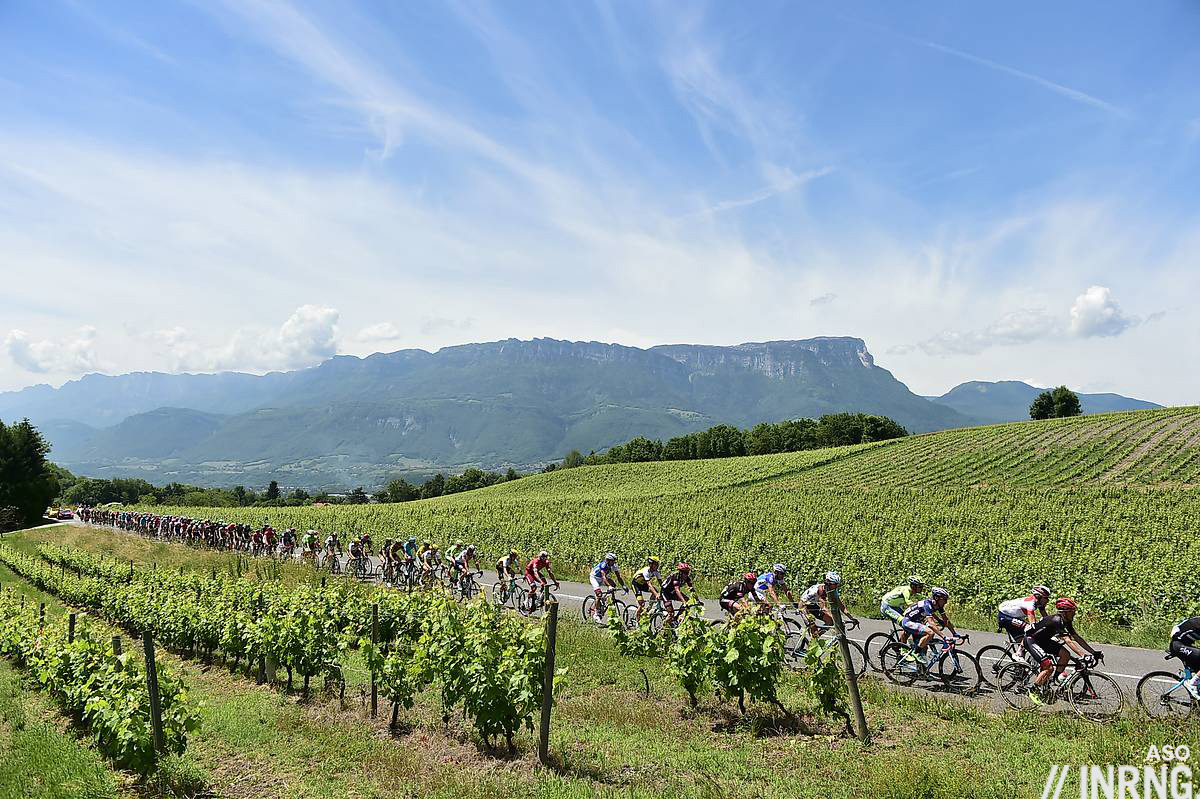The route for the 2017 Critérium du Dauphiné has been presented today, a chance to project beyond the spring classics into summer. The Dauphiné is often seen in the shadow of the Tour de France because it borrows some of the same roads and acts a dress rehearsal for July, even with some copycat stages. It runs from Sunday 4 June to Sunday 11 June. Here’s a closer look at the route ahead.

Stage 1 is a hilly circuit race around the industrial city of Saint Etienne. The uphill start via the Col du Pillon sets the tone and then there’s a tricky circuit finish with a climb of 3.4km at 5.5%, enough to thwart some sprinters already.

Stage 2 looks mountainous but these are rolling roads. The race twitter account says “a bunch sprint is expected” but the sprinters will need their climbing legs given the hilly circuit in the finish where the road from Arlanc to Novacelles is a good 7km at 5%. Stage 3 is the longest stage of the week at 184km and the route will satisfy the sprinters.

Stage 4 is a short time trial on rolling roads in the countryside, ideal picnic territory for spectators. Stage 5 is the gourmet day for followers as the race heads to Macon via some famous Burgundy vineyards, notably Pouilly-Fuissé and a sprint finish is on the cards.

Stage 6 ventures into the Jura and shares the final 50km with Stage 9 of the Tour de France as with the climb of the Mont du Chat and its fast descent before the finish La Motte Servolex, home to the service course of the Ag2r La Mondiale team (in July it’s Chambéry).

Stage 7 features Alpe d’Huez only with a difference. After the stage start in Aoste (not to be confused with Aosta in Italy, but the name is exploited by a local meat factory hoping it can do just this with its “Jambon d’Aoste” label). Anyway they traverse the Chatreuse massif, the Cucheron and Porte duology rather than the famous trilogy and then proceed up the Romanche valley to the foot of Alpe d’Huez. However instead of taking the main road with its famous 21 hairpins the race will climb via the steeper Col de Sarenne, 15.3km at 6.9% but it’s got a descent mid way so the typical slope for the final kilometres is 9% or more before it reaches almost 2000m above sea level. Then comes a descent down to the famous ski resort and then onwards down towards the top of the village of Huez before climbing back up for 3.7km back to Alpe d’Huez.

They’ve saved the best for last. Stage 8 is just 115km and packed with over 4,000 metres of vertical gain. First come the picture-postcard climbs of the Col des Saisies, the Col des Aravis and the Col de la Colombière. Then comes the novelty, the climb to the Plateau de Solaison. At 11.3km and 9.2% this is a very tough climb but the stats only tell part of the story. It’s an irregular climb, more goat path than a ski station access road and all the better for it, the kind of road where the team buses will have to park at the bottom because they’d never make it up. It’s familiar to some as it was used in the 2014 Tour de l’Avenir and the top-10 that day was packed with promising climbing talent and there were big time gaps too.

Route Summary
The mid-race time trial makes a return only it’s of little comfort to the time trial riders who might hope to hang on in the mountains. Instead the route looks perfect for the usual suspects like Chris Froome and Richie Porte given the two big summit finishes and the tricky Mont du Chat, there’s a lot of climbs with double-digit gradients which reduces things everyone for themselves, perhaps a policy antidote to Team Sky strangling the race . The descent off the Mont du Chat might tempt others like Romain Bardet and having just watched Paris-Nice the final stage of the Dauphiné looks ideal for Alberto Contador.
Who wins isn’t just a matter of the course, it’s all dependent on participation though with the Tour de Suisse and the new Hammer race. Last year saw the Velon teams link up with the Tour de Suisse but it didn’t stop the Dauphiné getting a very strong field last year, indeed the Velon teams sent plenty of their best riders to the Dauphiné anyway. As much as financial interests are at play in the background come June and sporting interests are right in the foreground and so the timing, the route of the Dauphiné as well as habits make the Dauphiné a stepping stone to the Tour de France.



Looks like it’ll be a brutally tough race. Having such a tough final stage with a summit finish should hopefully mean that there are still several riders in contention right to the end. Can’t wait.
Do you think the parcours might mean fewer sprinters enter at all?
I suspect they will. Last year many sprinters stayed away leaving wins for Nacer Bouhanni and Edvald Boasson Hagen and the second victory was a harder uphill sprint too.
I seem to recall when they did the Huez double with the Sarenne that it was quite special – the commentary at the time said they had repaired and paved sections of the road since during the winter it is covered with snow and historically would be in poor shape come summertime. I figured that this might mean whenever I planned a return trip to the area years later the road might not be much fun to descend. I guess this means another round of maintenance and improvements, which is good news for this weekend warrior cyclotourist!
The Sarenne used to have these large open drains to ride through but they fixed that. The climb though has a section where the road is cut into the rock and the rock is schist-like and crumbles all over the road. This should get a good tidy up for the race but I suspect it’ll be full of debris soon after, especially of there’s heavy rain, a thunderstorm etc.
Plateau de Solaison is a great climb, lovely empty road, bit of a ropey surface up the top but very beautiful as it runs across the cliff and then onto the plateau itself. Tough too so should make for a great stage.
I love the route. Alpe d’Huez via Sarenne makes me so happy versus the typical 21 hairpins.
Stage 8 is great. Solaison is tough. It’s a great climb for cyclo-tourists as very quiet with a fabulous cliff stretch. If you know where to look while driving the auto-route between Geneva and Chamonix you can see this stretch high on the right. If anyone rides it, I encourage you to descend via the also interesting Gorges du Bronze beside the climb or to visit Plateau d’Andey on the other side.
Solaison is not very well known, I hope you don’t mind me posting a link to the last time I rode it:
http://www.cycling-challenge.com/plateau-de-solaison/
Post away, as ever the links are informative and valuable and if reader’s haven’t visited, do go browse because Will’s site is a superb resource for climbs and Alpine routes.
When the Tour de l’Avenir visited Solaison* the time gaps were huge and the first 40 riders were coming in one by one for five minutes. Now this won’t happen in the Dauphiné but it does say how tough the climb is.
The stage was won by Astana stagiaire Ilya Davidenok who subsequently tested positive, so Sam Oomen, today with Team Sunweb, was the rightful winner.
Cheers,
I’ll spam you one more link I think might be useful for visitors. If anyone wants to ride Mont du Chat from the west side – like the Tour and Dauphiné – this is a great loop via the super scenic little Col du Chat above Lac du Bourget – biggest lake in France.
http://www.cycling-challenge.com/mont-du-chat-via-col-du-chat/
Another good loop possible via Col de l’Epine or truly giant loops with Grand Colombier or Mont Revard – but too tough for my legs 🙂 .
Thanks for the posting. Gorgeous places. You made me jealous!!!
Still can’t get over Chris Froome’s hat – Sky’s level of disorganisation apparently even stretches to an inability to measure his head.